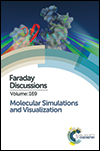ExaViz: a flexible framework to analyse, steer and interact with molecular dynamics simulations
Abstract
The amount of data generated by molecular dynamics simulations of large molecular assemblies and the sheer size and complexity of the systems studied call for new ways to analyse, steer and interact with such calculations. Traditionally, the analysis is performed off-line once the huge amount of simulation results have been saved to disks, thereby stressing the supercomputer I/O systems, and making it increasingly difficult to handle post-processing and analysis from the scientist's office. The ExaViz framework is an alternative approach developed to couple the simulation with analysis tools to process the data as close as possible to their source of creation, saving a reduced, more manageable and pre-processed data set to disk. ExaViz supports a large variety of analysis and steering scenarios. Our framework can be used for live sessions (simulations short enough to be fully followed by the user) as well as batch sessions (long-time batch executions). During interactive sessions, at runtime, the user can display plots from analysis, visualise the molecular system and steer the simulation with a haptic device. We also emphasise how a CAVE-like immersive environment could be used to leverage such simulations, offering a large display surface to view and intuitively navigate the molecular system.
- This article is part of the themed collection: Molecular Simulations and Visualization

 Please wait while we load your content...
Please wait while we load your content...